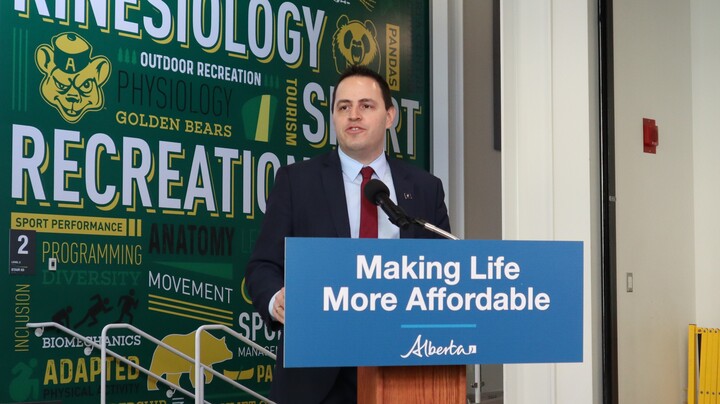Budget 2023 Q&A with Demetrios Nicolaides, Minister of Advanced Education
Minister Nicolaides answered questions about targeted enrolment, affordability measures, deconsolidation, and other investments.
 Lily Polenchuk
Lily PolenchukOn February 28, the United Conservative Party released Budget 2023, promising multiple investments in post-secondary education, new affordability measures for students, and enrolment expansion.
The Gateway interviewed Minister of Advanced Education Demetrios Nicolaides to ask about Budget 2023, and its impacts on post-secondary education in Alberta.
The following interview has been edited for brevity and clarity.
Q: What are the main takeaways from this budget for post-secondary students and staff in Alberta?
Demetrios Nicolaides: There are two key takeaways for post-secondary students, staff, and others in the post-secondary system as a whole. Takeaway number one is that the government is making targeted investments in areas that are going to help more students have access to spaces at our incredible universities and colleges, and help prepare them for what our economy needs.
The second key takeaway that I think is critically important for students, are the measures that will help make things more affordable. We’ll be instituting a new cap on tuition, and changing some of the rules around student loans and interest rates, to help our students weather the storm. We’re in some very challenging inflationary times. I think we’re in a fortunate position as a province where we have a balanced budget, we have a surplus, we’re able to provide students and more Albertans relief during these very difficult times.
Q: The two per cent tuition cap is set to go into effect in 2024-25, allowing post-secondary institutions to go through with their proposed tuition increases for 2023-24. Why did the government decide to implement the cap for the following year?
Nicolaides: It’s very important that we give our universities and colleges adequate time to be able to make their plans and prepare. It takes months and months for institutions like the University of Alberta and others to develop their budgets and make those decisions.
For many of our universities and colleges, decisions have already been made for the 2023-24 academic year. We don’t want to pull the rug out from anyone and cause uncertainty and disruption. So by targeting this to be implemented in 2024-25, we can give everybody enough time to adjust their budgets, and make the appropriate plans that they need to.
Q: Because of four-years’ worth of cuts to the Campus Alberta Grant and academic restructuring, the U of A has lost 1,050 staff, and students and faculty are feeling the negative effects of a more centralized managerial model. How does the government plan on making sure universities can have an adequate student to faculty ratio?
Nicolaides: I think one of the important things that we have to do is make sure that we are using taxpayer dollars efficiently and effectively. We also need to make sure that we’re in alignment with other provinces. We are currently in alignment with other provinces as it stands; in accordance with the 2020-21 year, the U of A receives the second highest amount of funding per student than any other university in the U15 category — $13,950 in operating funding per student.
That’s second only to the University of Saskatchewan, which receives $15,000 in funding per student. So, our universities and colleges in Alberta are still well-funded in comparison to other provinces and their counterparts. The average across the U15 is about $10,000 per student in provincial operating funding, the U of A is just under $14,000. They’re still very well-funded, and and I think that can ensure that they’re able to succeed and deliver high-quality programs, and exceptional services to their students.
Q: The government has reduced the overall operating funding of post-secondaries significantly over the past four years, and now we are seeing some investment in “targeted enrolment expansion.” What would you say to someone who thinks the government is only willing to fund particular programs that benefit them, valuing some students more than others?
Nicolaides: The programs that we’re funding benefit students — we are looking at programs where there is highest demand. I think we can all agree that we should not be turning away qualified students, but we do that quite a bit in many programs. The entire purpose of targeted enrolment is designed to try and eliminate some of those waits — we don’t want students to have to wait years to get into a program.
It’s about making sure that when the next generation is graduating from high school, and they want to get into a program — whether that’s nursing, fine arts, business, technology, whatever it is — that we have the spaces here in Alberta to be able to accommodate them. So what we’ve done, is we’ve looked at the programs that have the highest demand, where we’re turning students away, and where we need to increase spaces.
Q: The budget lists high-demand programs for targeted enrolment as non-trade construction, energy, technology, and business. Who decides what’s a high-demand program?
Nicolaides: For the round of funding that we’re providing in Budget 2023, we’ve looked at forecast data from the Ministry of Jobs, Economy and Northern Development. We looked at the projections for 2030, and we saw very clearly that in those areas, if we don’t take any measure, we won’t have enough people to to help those industries move forward. That includes healthcare, nursing, non-trades construction, engineering, aviation, and other areas.
Q: What does funding look like for Campus Saint-Jean (CSJ) in this budget?
Nicolaides: There have been significant increases in the budget for French language support. A lot of that is attributed to the deal that the province has signed with the federal government, where we’ve both come to the table and agreed to chip in and provide additional funding, specifically for CSJ. Apart from that individual agreement, the Government of Alberta does not provide funding directly to CSJ — we provide funding to the U of A, which manages its operations.
With respect to the the agreement, it’s a total of $15.5 million for CSJ, and that extends for a three year period from 2021-24. $10.3 million of that is federal investment, $2.5 million is coming from the Government of Alberta, and another $2.6 million is being reinvested from the University of Alberta, as they’re redirecting some of their funding.
Q: Are there any changes to performance-based funding in this budget?
Nicolaides: Not directly tied to the budget, but we will be moving forward with the schedule that we have, to increase the proportion of funding that is at risk. I believe 15 per cent of funding is at risk for the upcoming year, depending on their ability to to achieve their their key metrics. It’s not an all or nothing, of course; it’s scalable. The performance-based funding model is not intended to be an arrangement where you have to hit this, or else your funding is going to be cut. It’s designed to provide greater clarity over what the government is looking the institution to do, in return for the funding that we provide.
Q: Last year, the U of A president said in 2023, post-secondaries will deconsolidate from the governments’ financial statements, so that they can spend their carry forward funds more freely. Why is there no mention of deconsolidation in this budget?
Nicolaides: The Government of Alberta does not determine whether or not an institution is financially deconsolidated from government or not. That is effectively an interpretation, opinion, and decision of the Auditor General. The reason our finances are consolidated, and all of every dollar that’s spent by the U of A and other universities has to be reported on the government’s books, is because of the level of control that exists. The Auditor General has determined decades ago that because of the nature of this relationship, all of the financials should be recorded together.
If we want to move away from that, it means that the Government of Alberta has to relax a lot of the controls that exist, which we’ve been talking about with the U of A in a lot of detail, and we’re looking at those measures. There’s a provincial election starting in eight weeks, and there’s not a lot of ability for us legislatively, and from a policy standpoint to get a lot of work done over the next eight weeks. So I’m hopeful that the conversation and policy-work can continue in June and in the months thereafter.
Q: Following four years of across-the-board tuition increases and exceptional tuition increases, do you think these new affordability measures are going to make a meaningful difference?
Nicolaides: Yeah, absolutely. The cap that we’re putting in place at two per cent, just to be really clear, is the most conservative cap that has ever existed on tuition in Alberta, in the entire history of the province. There has never been a cap that provides this level of stability and predictability for students. So I think this is a very important milestone for students in terms of predictability and stability.
The other changes that we’re making to interest rates, grace periods, and increasing financial assistance to the Alberta Student Grant and other scholarships and awards — I think will benefit students and will help students. I’m happy to see that the province as a whole is in a strong financial position, which gives us the ability to do this.
Every year, The Gateway publishes hundreds of articles like the one you just read that are free for everyone to access. But The Gateway needs your support to continue publishing its award-winning journalism. Please consider donating today, even a small amount can help the University of Alberta’s only newspaper continue serving the campus community. Thank you.




